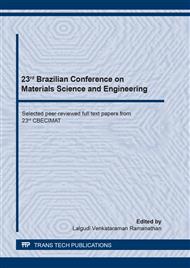p.94
p.100
p.109
p.114
p.119
p.125
p.131
p.136
p.141
Effect of the Heat Treatment on the Microstructure and Morphology of Cigs Thin Films Prepared by RF Magnetron Sputtering at Room Temperature
Abstract:
This work investigates the microstructural and morphological changes on CIGS thin films submitted to a post-deposition heat treatment. The CIGS 1000 nm-thick films were deposited at room temperature by RF magnetron sputtering onto glass substrates covered with molybdenum films. After deposition, the samples were submitted to a heat treatment, with temperatures ranging from 450 to 575 oC. The treatment was also carried out under a selenium atmosphere (selenization), from 400 to 500 oC. Morphological analyzes showed that the as-deposited film was uniform and amorphous. When the treatment was carried out without selenization, the crystallization occurred at or above 450 oC, and the grains remained nanosized. However, high temperatures led to the formation of discontinuities on the film surface and the formation of extra phases, as confirmed by X-ray diffraction data. The crystallization of the films treated under selenium atmosphere took place at lower temperatures. However, above 450 °C the film surface was discontinuous, with a lot of holes, whose amount increased with the temperature, showing that the selenization process was very aggressive. X-ray diffraction analyses showed that the extra phases were eliminated during selenization and the films had a preferential orientation along [112] direction. The results indicate that in the manufacturing process of solar cells, CIGS films deposited at room temperature should be submitted to a heat treatment carried out at 450 °C (without selenization) or 400 °C (with selenization).
Info:
Periodical:
Pages:
119-124
Citation:
Online since:
October 2020
Keywords:
Price:
Сopyright:
© 2020 Trans Tech Publications Ltd. All Rights Reserved
Share:
Citation:


